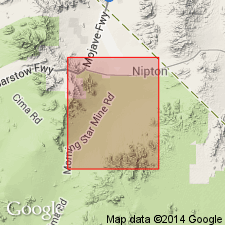
- Usage in publication:
-
- Beck Spring dolomite*
- Modifications:
-
- Original reference
- Dominant lithology:
-
- Dolomite
- AAPG geologic province:
-
- Great Basin province
Summary:
Pg. 240; USGS Prof. Paper 275, p. 26, 28, pl. 1, 1956. Beck Spring dolomite. Consists largely of beds of light-bluish-gray dolomite, 2 to 4 feet thick, separated by layers of shaly material; contains numerous beds of oolite several feet thick. No clearly identifiable fossils present, but layers of roundish concretions about one-half inch in diameter may be of algal origin. Thickness about 1,000 feet. Conformably underlies Kingston Peak Formation (new); conformably overlies Crystal Spring Formation (new) (both of Pahrump series). Age is Precambrian.
Crops out in belt 6 mi long on north slope of Kingston Range, Ivanpah quadrangle, [Inyo Co., southern CA]. Named from Beck Spring on north slope of range.
Source: US geologic names lexicon (USGS Bull. 1200, p. 264-265); supplemental information from GNU records (USGS DDS-6; Menlo GNULEX).
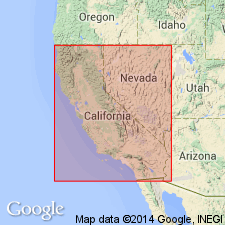
- Usage in publication:
-
- Beck Spring dolomite
- Modifications:
-
- Areal extent
- AAPG geologic province:
-
- Great Basin province
Summary:
Pg. 7 (fig. 3), 12, 13. Beck Spring dolomite. Described in Superior talc area, San Bernardino County, Death Valley region, southern California. This is most westerly known occurrence of unit. Composed mostly of light-brown fine-grained dolomite containing subordinate olive-gray to light-brown quartzite and shale; dolomite beds are commonly 2 to 10 feet thick and locally contain thin siliceous layers parallel with bedding; quartzite and shale layers range in thickness from few inches to as much as 20 feet and are most abundant in upper 200 feet of formation. Thickness about 1,300 feet. Overlies Crystal Spring formation; underlies Kingston Peak formation [all three units part of Pahrump series, now called "Pahrump Group"].
Source: US geologic names lexicon (USGS Bull. 1200, p. 264-265); supplemental information from GNU records (USGS DDS-6; Menlo GNULEX).
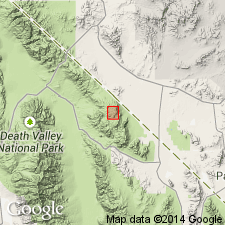
- Usage in publication:
-
- Beck Spring Dolomite*
- Modifications:
-
- Age modified
- AAPG geologic province:
-
- Great Basin province
Summary:
Beck Spring Dolomite (middle unit in Pahrump Group) is late Precambrian age. In area where Noonday Dolomite truncates Pahrump Group between Death Valley and Kingston Range, Noonday locally unconformably overlies Beck Spring Dolomite. In Funeral Mountains Troxel and Wright (1968) suggested that strata below Johnnie Formation may be correlative with all three members of Pahrump Group.
Source: GNU records (USGS DDS-6; Menlo GNULEX).
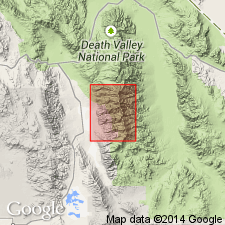
- Usage in publication:
-
- Beck Spring Dolomite*
- Modifications:
-
- Areal extent
- AAPG geologic province:
-
- Great Basin province
Summary:
Mapped in Telescope Peak 15' quad, Panamint Valley, CA. Originally named Marvel Dolomitic Limestone by Murphy (1930, 1932) but correlated with Beck Spring Dolomite of Hewett (1940) by Albee and Lanphere (1962). Consists of 200 to 300 m of blue-gray to buff massive siliceous dolomite and its metamorphosed equivalent, tremolite-dolomite marble. Thin wavy laminae and stromatolites are preserved on Sentinel Peak. Interbeds of intraformational conglomerate and argillite occur where top part of unit interfingers with clastic rocks of overlying Kingston Peak Formation. Assigned Proterozoic age.
Source: GNU records (USGS DDS-6; Menlo GNULEX).
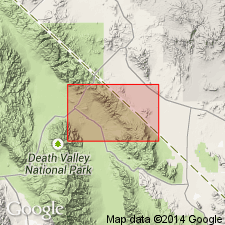
- Usage in publication:
-
- Beck Spring Dolomite*
- Modifications:
-
- Areal extent
- AAPG geologic province:
-
- Great Basin province
Summary:
Unit geographically extended into report area [north Funeral Mountains]. Age given as [Middle?] Proterozoic here.
Source: GNU records (USGS DDS-6; Menlo GNULEX).
For more information, please contact Nancy Stamm, Geologic Names Committee Secretary.
Asterisk (*) indicates published by U.S. Geological Survey authors.
"No current usage" (†) implies that a name has been abandoned or has fallen into disuse. Former usage and, if known, replacement name given in parentheses ( ).
Slash (/) indicates name conflicts with nomenclatural guidelines (CSN, 1933; ACSN, 1961, 1970; NACSN, 1983, 2005, 2021). May be explained within brackets ([ ]).

